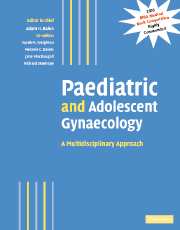Book contents
- Frontmatter
- Contents
- Contributors
- Preface
- Part I Normal development
- Part II Management of developmental abnormalities of the genital tract
- 9 Management of ambiguous genitalia at birth
- 10 Imaging of the female pelvis in the evaluation of developmental anomalies
- 11 Surgical correction of vaginal and other anomalies
- 12 Laparoscopic techniques
- 13 A nonsurgical approach to the treatment of vaginal agenesis
- 14 Psychological care in disorders of sexual differentiation and determination
- 15 The needs of the adolescent patient and her parents in the clinic
- 16 Communicating a diagnosis
- 17 Patients and parents in decision making and management
- Part III Management of specific disorders
- Index
- Plate section
- References
14 - Psychological care in disorders of sexual differentiation and determination
from Part II - Management of developmental abnormalities of the genital tract
Published online by Cambridge University Press: 04 May 2010
- Frontmatter
- Contents
- Contributors
- Preface
- Part I Normal development
- Part II Management of developmental abnormalities of the genital tract
- 9 Management of ambiguous genitalia at birth
- 10 Imaging of the female pelvis in the evaluation of developmental anomalies
- 11 Surgical correction of vaginal and other anomalies
- 12 Laparoscopic techniques
- 13 A nonsurgical approach to the treatment of vaginal agenesis
- 14 Psychological care in disorders of sexual differentiation and determination
- 15 The needs of the adolescent patient and her parents in the clinic
- 16 Communicating a diagnosis
- 17 Patients and parents in decision making and management
- Part III Management of specific disorders
- Index
- Plate section
- References
Summary
Psychosocial functioning and quality of life are of increasing emphasis in consideration of outcome for people with chronic health conditions. The World Health Organization's assessment of quality of life has six domains, three of which refer to psychosocial outcomes (WHOQOL group, 1995). While few will experience clinically significant psychopathology, children with chronic illness are more likely to have psychosocial problems and a child's illness can impact on the whole family (Drotar and Crawford 1985; Eiser, 1990; Wallander et al., 1989).
Healthcare services for children and adolescents with disorders of sexual differentiation and determination (DSDD) are in part aimed at the prevention of psychopathological responses to diagnosis and treatment. Medical and nursing staff aim to provide healthcare that is designed to be sensitive to patients' psychological needs, but it is acknowledged that specialist psychosocial care should also be available and integrated with the medical care. A clinical psychologist or other applied psychologist in a health setting with experience of DSDD generally provides this service.
The psychologist has a dual role of supporting the family and working with the wider team to ensure that individual child or family needs are incorporated into treatment from the outset. Recognition of the psychological components of healthcare does not represent a presumption of psychological disorder, rather an acknowledgement of the possible impact on the child's psychological development and the wider family adaptation.
- Type
- Chapter
- Information
- Paediatric and Adolescent GynaecologyA Multidisciplinary Approach, pp. 158 - 178Publisher: Cambridge University PressPrint publication year: 2004
References
- 8
- Cited by



